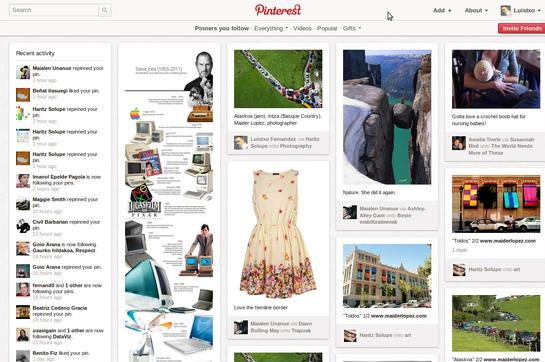
Social platforms can be trendy. Outside of the big boys — Facebook, Twitter, YouTube — there’s a second tier that trades the title of the Next Big Thing. Lately Pinterest has had its turn in the spotlight.
Yet for many news publishers, which often tend to judge social platforms by the hard metric of traffic referrals, Pinterest is a dud. Publishers like The Wall Street Journal, The New York Times and Self are experimenting with it but overall Pinterest is not driving that much traffic.
A recent study from Buzzfeed underscored this. It examined traffic to the Buzzfeed Network, which reaches 300 million people each month across more than 125 publishers, over the first half of 2012. Facebook and Twitter were, as you’d expect, juggernauts, accounting for 53 million and 21 million referrals respectively in June. Pinterest, not so much. It sent publishers a mere 110,000 referrals, far less than the other social networks, including Reddit, which referred a little more than 5 million. Perhaps even more alarming, that flow is going in the wrong direction, dropping nearly two thirds from two months earlier.
It begs the question of just what many publishers get out of making Pinterest a plank in their social distribution strategy. And it belies a bigger truth: for many news publishers social isn’t really a big deal to them.
“As good as this is for our brand ubiquity, the truth is social networks aren’t driving huge amounts of traffic to NYTimes.com,” an NYT spokesperson said. “In March, less than 5 percent of traffic to our site came from Twitter and Facebook.”
Even The Atlantic, which claims about 40 percent of referrals come in through some type of social activity, doesn’t see much traffic coming from Pinterest. “Pinterest is not an effective referral tool for us,” said Scott Havens, svp digital and finance for The Atlantic, noting it’s not in the top 50 of its referrers.
To be sure these are two examples of publishers that don’t have much visual content. Their audiences, also, aren’t particularly focused on women. Yet even some of those publications are struggling to turn Pinterest into a big traffic source. Take Conde Nast’s Self, for example. Pinterest drove more traffic in June than Twitter with 60,000 uniques compared to 30,000. (Both are far behind Facebook with 115,000 uniques.) Even with the Pinterest boost, social is still small potatoes for Self, accounting for less than 4 percent of its traffic.
“We are embracing the Pinterest platform, after seeing Pinterest coming up in analytics in July 2011,” said Self’s social media editor Stephanie Miller. “Since then, it’s been steadily increasing. We use Pinterest to broaden the Self lifestyle, use it is a way to share inspirational images.”
There are some outlets, like Time Inc.’s Real Simple and Conde Nast’s Brides.com that are seeing some positive traction. Real Simple has 143,000 followers on Pinterest and according to a Real Simple spokesperson, Pinterest is the No. 1 source of traffic from social media.
Brides.com has 72 boards and 17,000 followers and according to Lisa Gooder, digital director at Brides.com, Pinterest is right behind Facebook and ahead of Twitter when it comes to traffic referrals from social media. “We have recently undergone a re-branding of the magazine and website, and Pinterest has been the perfect way to get our new look out there,” she said.
And this comes back to how people use Pinterest. It’s not a site for discovering or sharing textual content, which is the business that The Atlantic, the NYT and many other news publishers are in.
“I think Pinterest can be social platform to drive e-commerce, more so to the female demographic than males,” Havens said. “I see it more as an e-commerce driver than a traffic referral for news and analysis.”
More in Media

Meta AI rolls out several enhancements across apps and websites with its newest Llama 3
Meta AI, which first debuted in September, also got a number of updates including ways to search for real-time information through integrations with Google and Bing.

Walmart rolls out a self-serve, supplier-driven insights connector
The retail giant paired its insights unit Luminate with Walmart Connect to help suppliers optimize for customer consumption, just in time for the holidays, explained the company’s CRO Seth Dallaire.

Research Briefing: BuzzFeed pivots business to AI media and tech as publishers increase use of AI
In this week’s Digiday+ Research Briefing, we examine BuzzFeed’s plans to pivot the business to an AI-driven tech and media company, how marketers’ use of X and ad spending has dropped dramatically, and how agency executives are fed up with Meta’s ad platform bugs and overcharges, as seen in recent data from Digiday+ Research.





